Croatian Artist Alfred Freddy Krupa Sets Very Unusual World Record
April the 14th, 2023 - Under monitored conditions, Croatian artist Alfred Freddy Krupa drew 'My Panoramas' on a raw canvas of 69x892 format over the 10th and 11th of January 2023 in the drawing room of the Duga Resa High School's graphic design department.
In addition to creating large and in this case very large paintings, he wanted to draw attention to the painting-drawing form that he has been dealing with for many years and encourage a possible competition in that area.
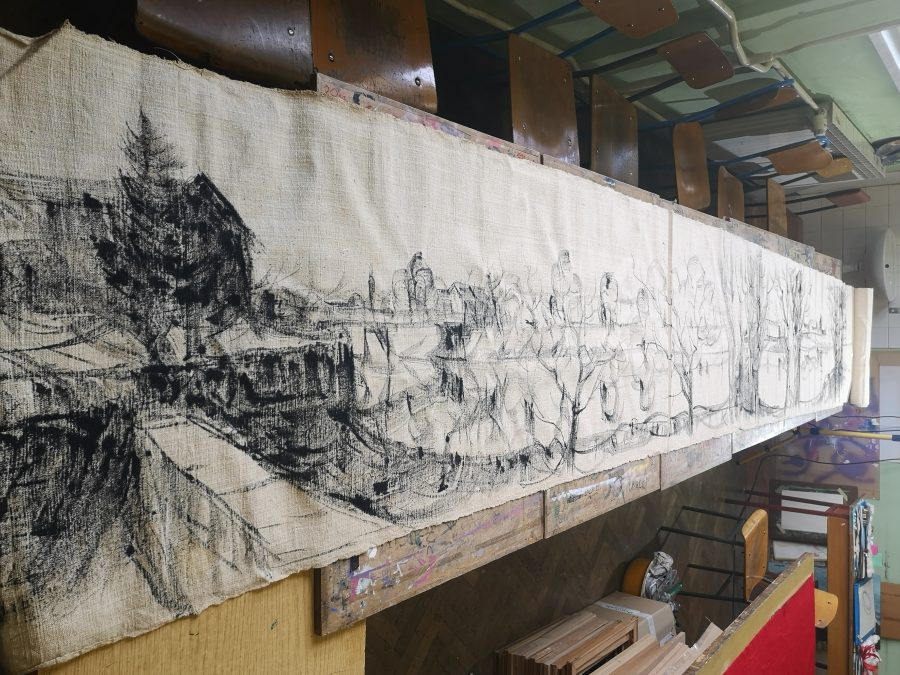
Croatian artist Alfred Freddy Krupa's work was recognized as the largest of its kind and a world record by the American organization RecordSetter.
By applying the publicly available table of Krupa's indicated values created by i-CAC, the market value of 'My Panoramas' would be around 92,000 Euros. Krupa has also been certified and ranked 15th in the Francophone world by the French organization, i-CAC (Indice de Cotation des Artistes Certifiés). Krupa was included because his previous artistic activity in France qualified him for membership in this organization exclusively for French and Francophone artists.
His work for i-CAC was evaluated by Olivier Houg, an expert member of the National Chamber of Specialists in Works of Art and Collections – Paris / Chambre Nationale des Experts Spécialisés en Objets d'Art et de Collection – Paris / as well as the European Confederation of Art Experts – Paris / Confédération Européenne Des Experts d'Art – Paris /).
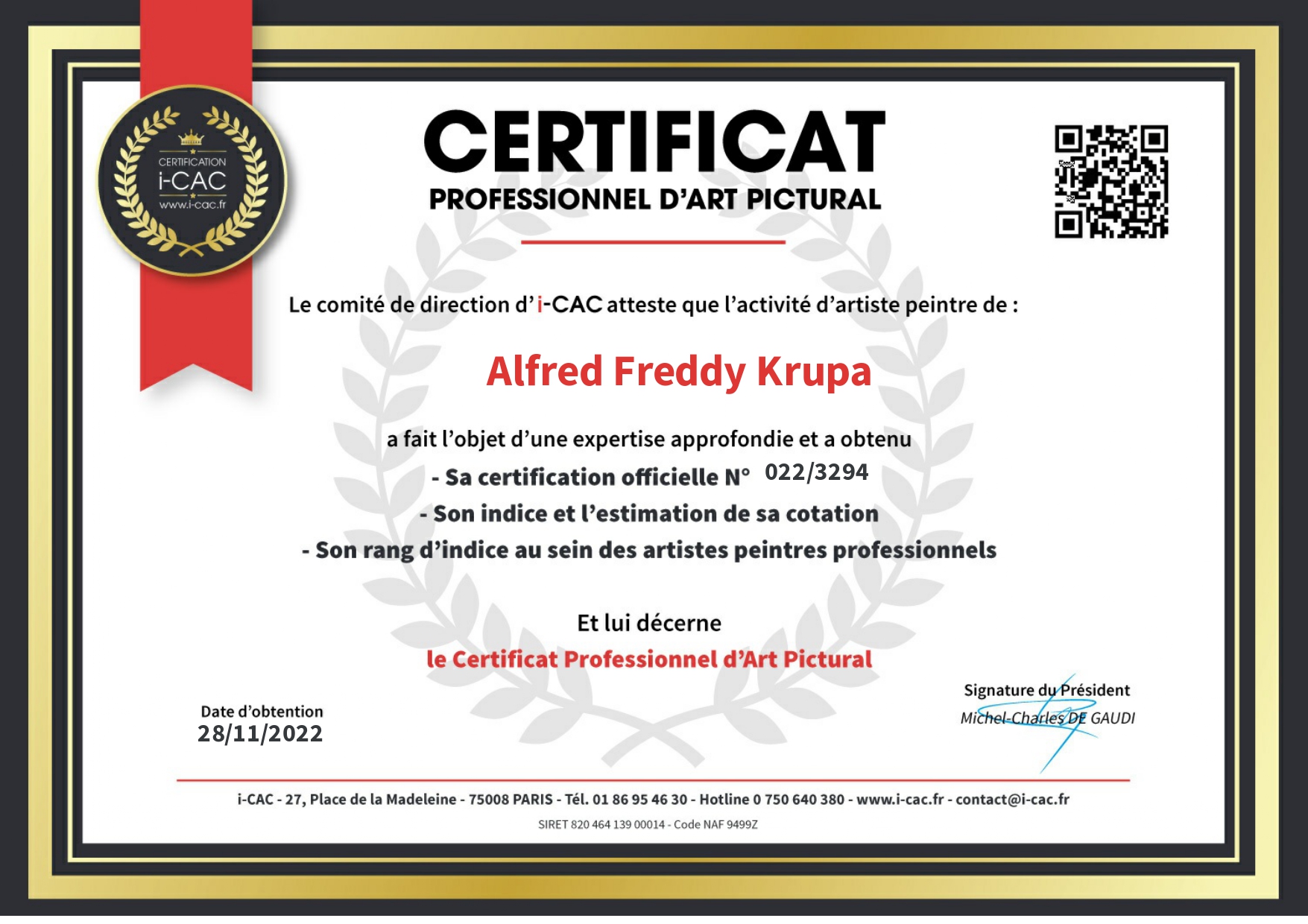
A series of awards and recognitions were awarded to Croatian artist Alfred Freddy Krupa over the last year, including winning the International Art Award New Generations 2022 (Miami, USA), winning the Japan Ink Painting Society Artist Award (Tokyo, Japan), and being named on the 7th Gold list of the world's best artists (Israel - Italy - USA - Germany).
For more, make sure to check out our dedicated lifestyle section.
Zagreb Advent Gems: Dagmar Meneghello's Art Collection
December 12, 2022 - The famous Croatian art collector exhibited part of her collection in her apartment at Krležin Gvozd in Zagreb. Every Friday and Saturday from 4 to 7 p.m. Dagmar Meneghello opens her home to all visitors who appreciate art.
Zagreb Advent, as they say at Večernji, received another must-visit cultural stop. The location is a private apartment at Krležin Gvozd 23 (on the second floor of which the Croatian author Miroslav Krleža lived until his death). The famous art collector Dagmar Meneghello returned to Zagreb after almost six decades of living in Palmižana on Hvar. She brought along the works of Zagreb painters that are part of her art collection. Following the theme of Advent and the joy that comes with it, she organised an Advent exhibition in her apartment that showcases the works of Šutej, Friščić, Eterović, and for the first time in Zagreb, Ivo Ćorković.

The exhibition can be viewed every Friday and Saturday from 4 to 7 p.m. during Dagmar’s open house days. In Zagreb, the movement of collectors opening their apartments to the public to show off their art is quite a novelty. Dagmar Meneghello learned of such a lifestyle in Germany and now finds it to be normal and necessary.
Dagmar Meneghello's art collection has about 3,000 works. It was collected over half a century, during which hundreds of artists created and exhibited at Dagmar’s home in Palmižana. Her Palmižana home was often the first contact of foreign visitors, mostly sailors, with Croatian culture and art. For fifty years, she invited artists to a tiny island, a gallery at the end of the world.
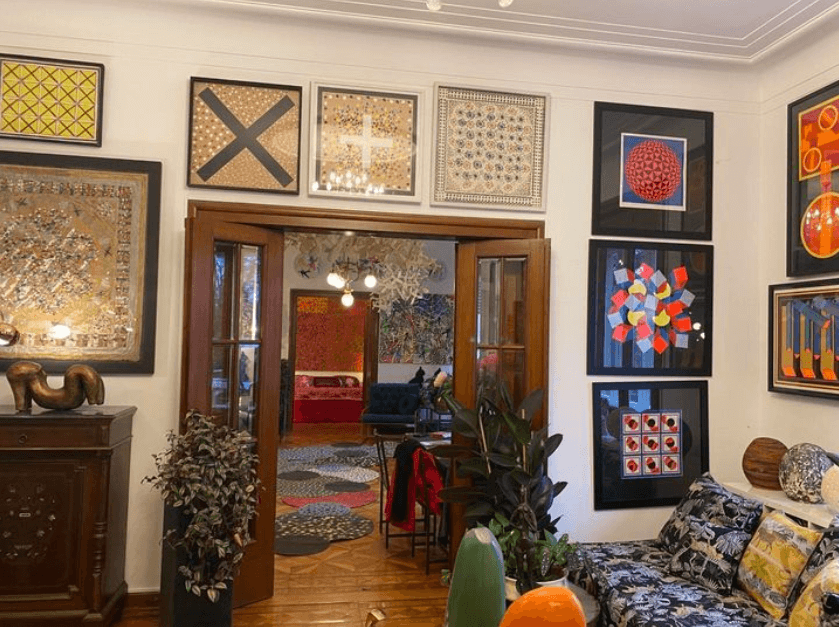
The works include numerous sculptors, from the great Kosta Angeli Radovani, Goldoni, Riba Lončarić, Kuzma Kovačić, Peruško Bogdanić to Petar Dolić and Petar Hranuelli, Alana Kajfeš, Vatroslav Kuliš, Bana Milenković, Toni Franović, Boris Demur, and Željko Jerman, to younger generations such as Paulina Jazvić, Koraljka Kovač, Nina Ivezić, Tisja Kljaković Braić. These days, numerous museums and institutions borrow and exhibit the collection.
Dagmar started her art journey at an early age while working as a journalist in Zagreb. Love took her to Palmižana, and now she started a foundation and is working to ensure that her luxurious collection gets a new permanent home.
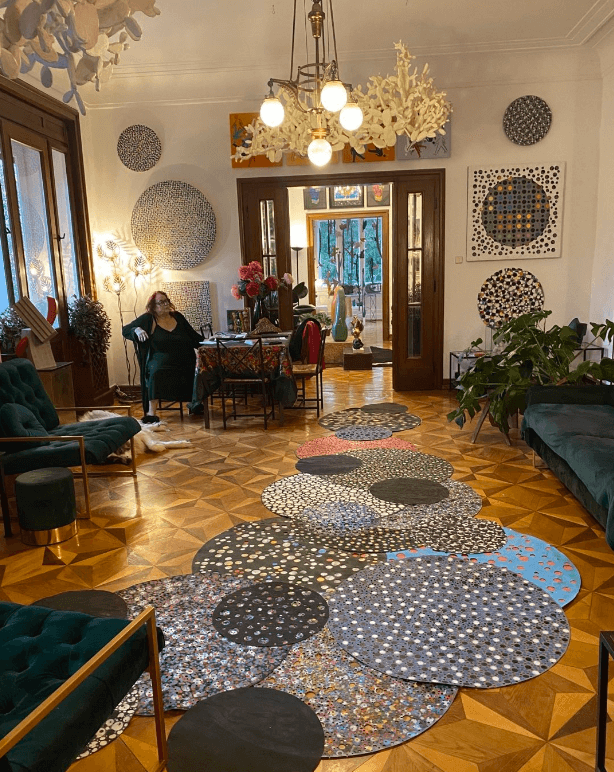
For more, make sure to check out our dedicated Travel section.
62 Croatian Works of Art Donated to Ukraine
ZAGREB, 18 July 2022 - A humanitarian campaign for Ukraine by the Croatian Association of Fine Artists' (HDLU) Vinkovci branch wrapped up in the eastern town of Vinkovci on Sunday with an exhibition and the handover of 62 works by 57 artists to the Ukrainian Embassy.
"We are giving these works of art to the Ukrainian people with the wish that they ennoble the walls of two to three schools and one institution in Ukraine, to be selected by the Ukrainians," said HDLU Vinkovci vice president Marko Lončar.
He said the exhibition was called Culture to Culture "because we Croats are giving part of our culture to Ukrainian culture."
He recalled that the campaign began in April with a donation exhibition called "Appeal to Assist Displaced Ukrainians" in Vinkovci, in cooperation with the Croatian Red Cross.
Thankful for the donation, Ukrainian Ambassador Vasyly Kyrylych said Croatia and its people strongly supported Ukraine since the start of the Russian aggression.
"Here in Vinkovci today, we see again that Croats strongly support Ukraine because they experienced and know what it means to defend one's state. We are grateful for that. We are strong in spirit and strong, not in hope, but in faith that we will win because we are defending our country, our homes, our families," he said.
"This is yet another aspect of our assistance to the Ukrainian people, with whom we empathize, confident that they will succeed in winning their freedom," said Vukovar-Srijem County head Damir Dekanić.
For more, check out our lifestyle section.
Optic Show Exhibition: Perspective and Women's Socks in MSU Zagreb
October 8, 2021 - The Optic Show Exhibition by Predrag Pavić set to be held at MSU Zagreb is a critical, interactive, and really fun artistic experience that is critical of today's consumerism habits.
From Sisak photographer Miroslav Arbutin Arba's exhibition to the education of young people who want to become museum curators, the Zagreb Contemporary Museum (MSU Zagreb) constantly has an interesting offer for its visitors.
One of them is the recently opened ''Optic Show'' exhibition by Predrag Pavić. Opened on October 6, the exhibition will last until October 26.
MSU rated Pavić as a type of artist who is becoming more and more in this day and age. He's an artist who turns his work into a game that is subversive, intriguing, and from time to time, even not all that serious. Pavić's work is already noted for being critical of consumerism and the modern society in which ''every weird little thing'' can earn the status of a fetish. The ''Optic Show'' at MSU Zagreb is no different, as it is a light show installation featuring an archive of no less than women's socks.
''It's true that women's socks entered the erotic-fetish domain long ago, but Pavić has since turned them into an art project which keeps being developed and added to, just like any archive. All the while, he amazes people with performance, participation from the visitors and his end effects,'' writes MSU Zagreb on its website.
The women's socks from Pavić's archive are placed within reversal films frames. The texture of a woman's sock becomes magnified and unclear in terms of what exactly it is from the observer's point of view. Observers are invited to pick through the archive, select reverse films, and put them into the projector. From that point on, what the exhibition brings, is everyone's guess and it differs from individual to individual.
''Predrag Pavić is one of the most interesting Croatian authors of his generation (born in 1982 in Zagreb). He freely expresses himself in various forms and mediums, from sculptures, installations, videos all the way to multimedia work, with his conceptual spirit being the starting point. In the process, his themes are the acceptance of the absurdity of the social surroundings in which he lives and works, and always with a discrete dose of humor,'' concluded MSU.
Learn more about Croatian Art Galleries in Zagreb, Dalmatia, Istria & Slavonia on our TC page.
For more about art in Croatia, follow TCN's dedicated page.
Smoqua Queer Festival Rijeka: A Safe Space for Diversity
October 2, 2021 - The fifth edition of the Smoqua Queer Festival Rijeka is set to celebrate diversity from October 7-9.
Culture, art, and interesting content mixed with the advocation of rights for sexual minorities, citizens and visitors of Rijeka are once again in for a queer culture treat as the fifth edition of the Smoqua festival of queer and feminist culture will take place from October 7-9.
''With our hearts full, we're announcing the 5th edition of Smoqua that will win you over with its diverse content, inspiring people, and warm atmosphere. LORI, together with our dear partners PaRiter and GSG, invite all persons of goodwill, an open mind and heart to join us in the new edition of joint reflection, conversation, mingling…'' says the Facebook description of the event.
As in previous years, Smoqua reminds visitors that they are offering a safe space for people that are different. For those that don't fit into gender and sex norms and boxes, but also those who are in need of open conversations, discussions, gaining new knowledge, and are curious about new realisations.
The 2021 edition is lead by a theme titled ''Uncharted territories''. In that spirit, Smoqua's events will explore the boundaries of the physical and the material within patriarchal structures, with the question of the body being the starting point. Activists and artists from all over Europe (the UK, Greece, Serbia, Poland, and France, to name a few) will participate in the programme. You canssee the whole programme as well as the venues and locations of all of the events here.
''Let’s dive together into queer and feminist culture through performances, an exhibition, discussions, workshops, lectures, a theatre play, the Queer-UP! Party and other various activities,'' says Smoqua.
The main organiser, the LORI association, is a Lesbian Organisation from Rijeka. Founded way back in October 2000, the organisation aims to inform and sensitise the public to accept sexual and gender minorities, as well as eradicate prejudice and homo/bi/transphobia. In a nutshell, their aim is to totally eliminate discrimination based on sexual orientation, gender/sex identity and/or gender expression and secure full equality under the law.
As TCN previously wrote, Croatia is rated to be the 39th most popular country for LGBTQ visitors in the world. In the summer of 2021, a famous actor and gay icon, Neil Patrick Harris visited the lovely Croatian Island of Hvar. 2021 and 2020, however, were also sadly noted for homophobic incidents.
From burning a gay effigy during an Imotski carnival in February 2020, a physical attack in Zagreb's Maksimir Park against a gay man, as well as several incidents against the participants during the 2021 Zagreb Gay Pride, Croatia isn't without its issues in this regard.
Learn more about LGBT rights in Croatia and what LGBT tourists should know on our TC page.
For more about LGBT in Croatia, follow TCN's dedicated page.
Tricky Women/Tricky Realities Festival Showcases Female Animation Authors
September 29, 2021 - The Tricky Women/Tricky Realities Festival online event presents Croatia with thirteen female animation authors who talk about gender inequality and other issues of the modern world.
Online event hosting obviously gained momentum during the coronavirus pandemic, as going out became risky for public health. The advent of the vaccine has seen Croatia slowly but steadily returning back to public event hosting, but there are some exceptions. Maybe it's the extra precauiton due to Croatian vaccine scepticism, or maybe just the possibility of less expensive organisation and more potential for attending regardless of your location on the map, but some events have remained online.
One such event is the Tricky Women/Tricky Realities Festival, a Vienna Film festival described by Culturenet as the only animated film festival focused on female authors. Organised by the Vox Feminae feminist news portal and the Austrian Culture Forum (AKF), the festival is being streamed on the websites of the organisers until October 10, making this an official (but only online) visit of the festival to Croatia. 13 short animated movies are selected for the online screening.
''From gender equality to digitalisation, from human and workers rights do social, economic and ecological issues, the Tricky Women/Tricky Realities Festival questions social and political reality from the feminist art perspective, pointing out social inequality in a new and innovative way,'' describes the Culturenet website.
The festival usually occurs on March 8 to commemorate International Women's Day. TCN is also no stranger to writing about noted women from Croatia's history or about current issues with gender equality, on March 8 and of course on many other days too.
The authors whose short animated work the festival presents are: Maya Yonesho, Susi Jirkuff, Ani Antonova, Rebecca Akoun, Veronika Schubert, Sabine Groschup, Beate Hecher i Markus Keim, Billy Roisz, Kathrin Steinbacher and Anna Vasof.
The films showcased are subtitled in English, making the event approachable to non-Croatian speakers too. As the 2021 edition is in progress, the plans for the 2022 edition are already ongoing. Interested female authors can apply for their work to be shown by October 4 this year, and the 2022 festival screening is scheduled from March 9-13 in 2022.
''We're proud to be able to announce a new award: The Maria Lassnig Golden Film Reel for outstanding animation will be awarded for the very first time in 2022. Sponsored by the Maria Lassnig Foundation, it is worth 10,000 euros and will be awarded annually. An international expert jury will select the winner from the films shown in the International Competition of our festival,'' announced the festival's official website.
The award, named after Maria Lasnig (1919-2014), who was a pioneer of experimental animation and one of the first women in the German-speaking world to be appointed to a professorship in art, shows this valuable festival is here to stay.
Learn more about Filming in Croatia in our TC guide.
For more about culture in Croatia, follow TCN's dedicated page.
Tisja Kljaković Braić Exhibition: Monument to a Living Person in Zagreb
September 28, 2021 - The Tisja Kljaković Braić exhibition titled "Monument to a Living Person" is honouring two decades of Braić's humorous, open and simple art. Authored by Frano Dulibić, the exhibition will be displayed at the Klovićevi Dvori Gallery until October 12.
The beautiful seventeenth-century building of Klovićevi Dvori in Zagreb's Upper Town (Gornji grad) is a piece of art itself. However, as this seventeenth century Jesuit monastery became one of the most known and respected art galleries in the whole country, you can expect plenty of art inside too.
If you have doubts (or you trust the statement completely and you want to enjoy some visual eye-candy), hop over to the venue at Jezuitski Trg 4 (Jesuit Square 4), for the monographic exhibition ''Monument to a Living Person'' that will be on until October 12.
The author of the exhibition is the art historian Dr. Frano Dulibić who gathered and displayed the work of the iconic Croatian painter Tisja Kraković Braić.
"Tisja Kljaković Braić has been part of the art scene for the last twenty years. After twenty years of dedicated work, there are many reasons to present the artist through a compilation of her best and most characteristic artwork. The exhibition at the Klovićevi Dvori Gallery will present her work from its initial phase of art brut painting, as well as her lyric, poetic paintings, sculptures, and drawings,'' Bulić said when explaining the motive of his display, as is written on Klovićevi Dvori's official website.
TCN readers may recall an interview with Kljaković Braić back in 2020 as she authored a book of caricatures on Dalmatian life entitled ''ONI'' (They).
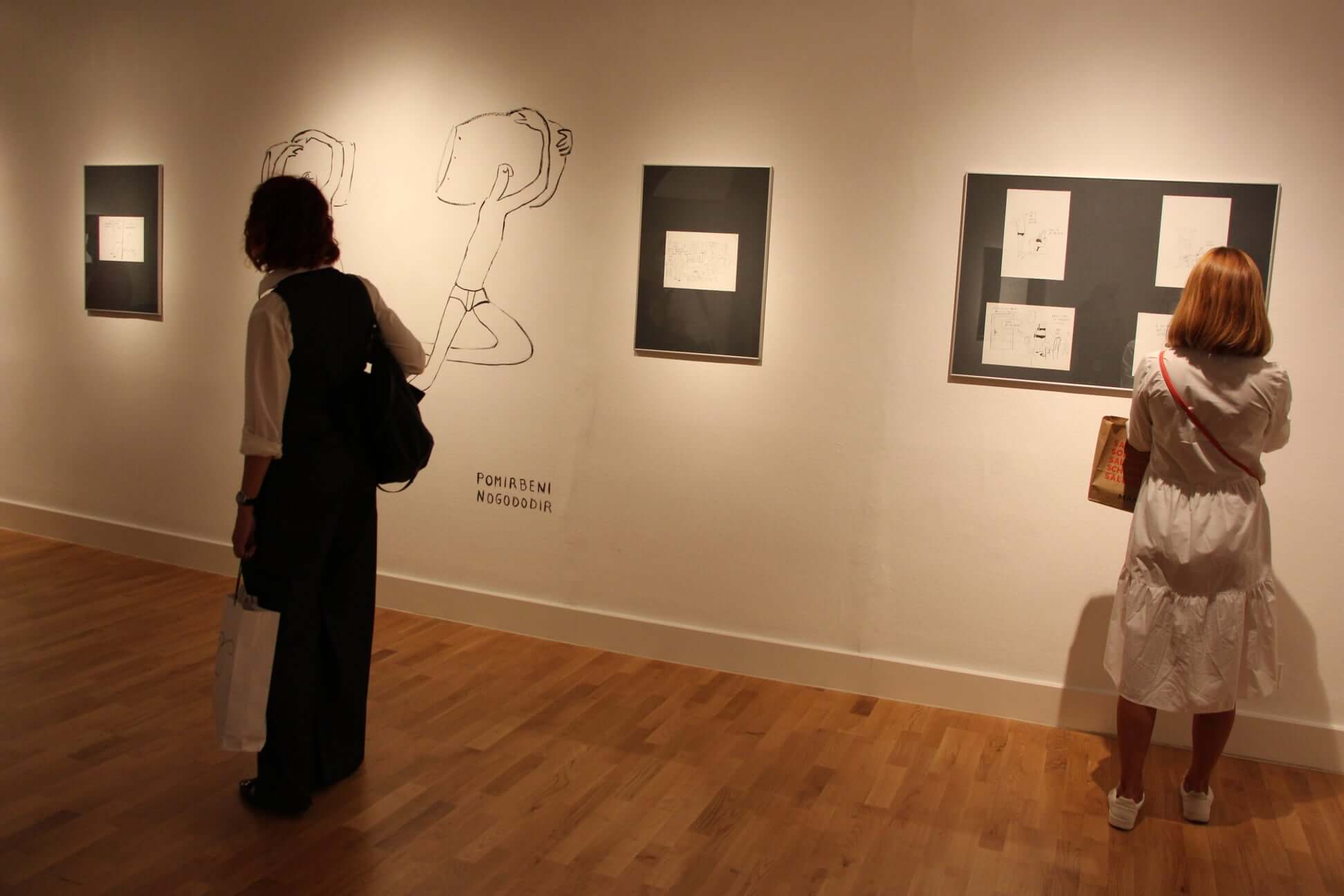
Scene from the "Monument to a Living Person" © Galerija Klovićevi dvori
''ONI'' are not left out in this exhibition either, and twenty years of Braić's work has made her art noted for its simple lines and shapes that gaze at you with openness, brazenness, honesty, and humor. It has been rated as primitive but certainly not in a bad way, quite on the contrary, due to effective ''waking up'' seen as a response from onlookers.
''With her primitivism, Tisja builds on many artistic paragons, from Paul Klee to Alberto Giacometti and Jean Dubuffet, who left significant marks on the art world. Nowadays, due to negative cultural implications, the art world seeks to avoid the term ''primitivism'' and appropriately replace it. At this point, the inevitable question arises: what is it in primitivist art forms that lures contemporary artists towards it, in a time of so many different art movements and ‘…isms’ passing us by?
The answer lies in an aspiration for disassociation from the frantic chase after something new and yet unseen, and an association with what is original, archetypal, primordial, and uncorrupted, that is, with the age when everything began,'' concludes Dulibić. Valentina Bach is the curator of this exhibition which is located on the first floor of Klovićevi Dvori. The gallery is open from Tuesday to Sunday, from 11:00 – 19:00.
Learn more about Croatian Art Galleries in Zagreb, Dalmatia, Istria & Slavonia on our TC page.
For more about art in Croatia, follow TCN's dedicated page.
Zagreb Subversive Festival 2021: Progressive Films and Discussions in October
September 28, 2021 - The Zagreb Subversive Festival 2021 will present movies and discussions on alternative, progressive solutions to burning global issues throughout October.
After the iconic Kino Europa (Europa Cinema) in Zagreb's centre closed down (despite huge support for it to remain, as well as protests), many cultural festivals that called the venue their home weren't sure where they would continue their cultural programmes.
However, many programmes successfully moved on, and the Zagreb Subversive Festival is no exception. The 14th edition of this progressive culture event is making a return to Zagreb and will last from October 3-23.
The Tuškanac Cinema, the Cultural Informative Centre (KIC), the Prosvjeta Serbian Cultural Centre (SKD Prosvjeta), and the Miroslav Krleža Institute of Lexicography joined forces to host the programme. Additionally, the online Volimdokumentarce.net (Ilovedocumentaries.net) programme will live stream online for those unable to attend the events in person.
''The Zagreb Subversive Festival 2021 is a multi-disciplinary platform inside which political theory and film join forces to shake up the status quo, identify the aesthetic of resistance and nurture a more radical approach to film, theory, and practice. We're interested in the potential transformation of our neoliberal daily lives, and the role art and culture could play in this endeavour,'' writes the official website of the Subversive Film Festival.
The festival began back in 2008, marking the 40th anniversary of 1968 global protests, and since then, it has evolved into one of the most important progressive festivals in the region. The festival is split into two sections: The Subversive Film Festival and the Subversive Forum.
The film part showcases movies that deal with topics of social injustice, social change, women's and minority rights, LGBTQ+, student and workers' issues and movements, as well as post-colonial heritage. The screenings also have a competitive nature due to the ''Wild Dreamer'' Award for the best feature, documentary, and short film categories.
The Subversive Forum portion of the festival holds conferences that present ''tools for the deconstruction of the offered normalised story about the world'', as well as the articulation of a possible alternative reality and its foundation.
Noted international movie directors, philosophers, social scientists, and activists such as Oliver Stone, Toni Negri, Slavoj Žižek, Michael Hardt, and many others have attended and participated in the Zagreb Subversive Festival over the years.
The 14th edition has a central topic, ''A Post-COVID Democracy: The Ethics of Fight and Solidarity Poetics'' and thirty movie titles are confirmed for the programme, which will be filled with exhibitions, lectures, and discussions that will stretch throughout the month of October.
Learn more about Zagreb in our TC guide.
For more about culture in Croatia, follow TCN's dedicated page.
Sisak Earthquake Photo Exhibition: Between Two Waitings by Miroslav Arbutina Arba
September 23, 2021 - The Sisak earthquake photo exhibition titled "Between Two Waitings" by Miroslav Arbutina Arba shows the horror of the 2020 earthquake in Sisak through documentary photos with an artistic touch.
The 6.3 magnitude earthquake on December 29 that severely damaged Petrinja and Sisak has traces which haven't faded as repairs and re-construction are still very much needed, and the Sisak earthquake photo exhibition will surely highlight the stark reality of post-earthquake life.
With Prime Minister Andrej Plenković promising earlier in September to accelerate post-earthquake reconstruction, a return to normal life in Sisak (architecture-wise) is yet to happen.
Meanwhile, as suffering is known to produce art, citizens of Zagreb (who also are not strangers to earthquakes) can closely observe the damage Sisak went through at Zagreb's Museum of Contemporary Art (MSU). In honour of European Heritage Day (September 18), MSU is hosting the Sisak City Museum by presenting the exhibition ''Between Two Waitings'' by famous Sisak photographer Miroslav Arbutina Arba. The exhibition opened on September 20, and it can be viewed until October 10.
The showcased photos which are part of the Sisak earthquake photo exhibition are a product of Arbutina being hired by the Culture Ministry to document the damage caused to cultural heritage for the purpose of evaluating the damage and producing documentation. As TCN reported earlier, the quake damage to cultural heritage in Central Croatia is estimated at €640 million.
''Arbutina gave a significant contribution to reconstruction efforts after the earthquake. His photos are, first and foremost, a witness to what happened, but with a clear artistic context. Photographing for the sake of documenting damage, he also found other motives that a regular observer does not notice. These motives, although they may exist in the documentary context, are nonetheless part of the same mosaic,'' wrote Vlatko Čakširan of the Sisak City Museum, who is also the curator for the exhibition on the MSU website.
''Those who haven't experienced this catastrophe probably think that losing your house is the worst thing, but it isn't. To me, the worse thing was expecting another new earthquake, that time of uncertainty between the two strikes,'' said Arbutina explaining the name of his exhibition.
Arbutina was born in Sisak on January 5, 1959. He took an interest in photography in the '80s when he got a Russian camera, a Lubitel, as a gift. Like many people in Sisak, he worked in a local ironware factory until he decided to try his hand at making a living solely from photography, taking industrial photos for brochures, etc.
During the Homeland War, he started working for various newspapers and other agencies. Enrolled in various projects (such as ''How Fish See Us'' where he took underwater photos of fish and plants in the Kupa river), his work received various rewards, and he moved from digital photography to experiment with the older technics of photography.
Learn more about Croatian Art Galleries in Zagreb, Dalmatia, Istria and Slavonia on our TC page.
For more about art in Croatia, follow TCN's dedicated page.
Dubrovnik-Bulgaria Connection: Scientific View on Art and History Ties
September 23, 2021 -The Dubrovnik-Bulgaria Connection stretches through centuries. A lecture by the Ivo Pilar Social Research Scientist Vinicije Lupis reveals some interesting details on their shared art and history.
Connections between Dubrovnik and Bulgaria date back to as early as the 13th century. These connections weren't just in a common, political sense, but also in the sense of art and cultural exchange, as noted by Georgius Bulgarus, a Bulgarian blacksmith that stayed in town back in 1218.
This fun fact is the opening of an invitation from the Ivo Pilar Social Research Institute to free up your schedule on September the 23rd for a lecture on the connection between Dubrovnik and Bulgaria by Vinicije B Lupis. The event starts at 19:00 at the Ivo Pilar Social Research Institute's Dubrovnik location, at the address: Od Kaštela 11.
Vinicije B. Lupis graduated in history and archaeology back in 1992 as well as in art history and theory in 1995, both times at Zadar University. Along with his MA on Ston's liturgy silver (1998) and his Ph.D. on the topic of the skull relics in the reliquary of the Dubrovnik Cathedral (2004), Lupis began his professional work in 1992 as a conservatory archaeologist in Split and then moved to work in Dubrovnik's Institute for the Protection of Cultural Monuments.
''Since 2007, Lupis has worked for the Ivo Pilar Social Research Institute, and from 2008 on, he has been the Head of the institute's Dubrovnik location. He has published hundreds of scientific papers and several books on the topic of sacral heritage, the art history of Dubrovnik and Boka Kotorska (Montenegro). He is the editor of multiple magazines and almanah's, and as an outside associate of the Croatian Radiotelevision (HRT), he gave his contribution to documentary series on Dubrovnik's history and heritage,'' reads the Ivo Pilar Social Research Institute on its website.
With the lecture being held in Croatian and as such not being very accessible to non-native-speakers, its worth noting some of the interesting key facts about Dubrovnik and Bulgaria that will be the subject of Lupis's lecture.
Lupis analyses the Renaissance painting of the Lady with Christ from the St. Kevork Armenian Church in Plovdiv, Bulgaria. He dated the picture to be from the beginning of the 16th century and connected it to the Dubrovnik painting circle (which is additionally interesting since this painting is the first renaissance painting in all of Bulgaria). The same church also holds the Engolpion (a medallion with an icon in the centre worn around the neck by Orthodox and Eastern Catholic bishops), which is close to the Dubrovnik-style of production at that time. This is just one example of Dubrovnik's influence on Bulgarian artistic heritage.
''The (Bulgarian) National gallery in Sofia holds the work of Croatian painters from the Dubrovnik area such as Vlaho Bukovac and Mato Celestin Medović. Dubrovnik as a place of inspiration is especially important for Bulgarian painters such as Bencho Yordanov Obreshkov and Mario Zhekov. Zhekov, the most significant Bulgarian marinist, painted an entire series of Dubrovnik landscapes,'' explains the Ivo Pilar Social Research Institute.
This should come as no surprise as the City of Dubrovnik, throughout its history, nurtured relations with various kingdoms and states. These include, as noted by the online edition of Croatian Encyclopedia, the then-Croatia, the Venetians, the Normans, and many others. Dubrovnik also became an independent republic, and history remembers the state for its great diplomacy ( which is valued by Croatian diplomats even today) and for abolishing slavery as early as 1416.
As TCN previously wrote, the Ivo Pilar Social Research Institute's scientists also made excellent connections with the Slovakian science community and explored the history of relations between the two countries. It has also since expanded its connection in Sarajevo, Bosnia and Herzegovina, as well as in Montenegro with regards to the ethnic Croats of Boka Kotorska.
Learn more about Croatian Art Galleries in Zagreb, Dalmatia, Istria & Slavonia on our TC page.
For more about history in Croatia, follow TCN's dedicated page.


